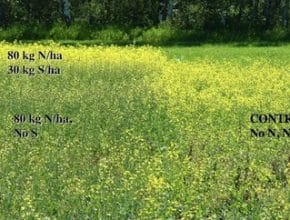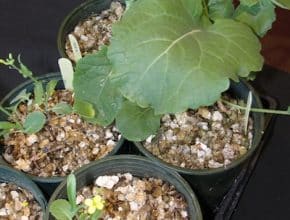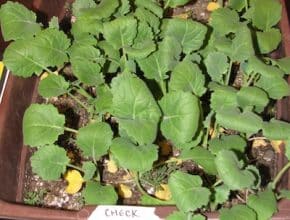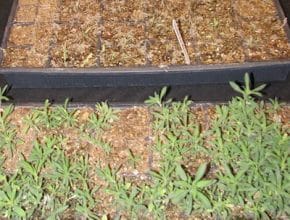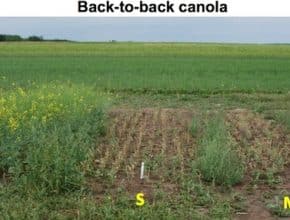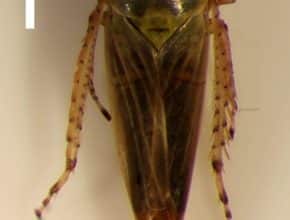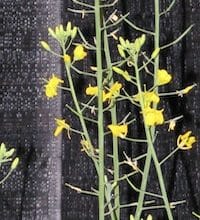Highlights from CanoLAB in Saskatoon include: —Why canola must have sulphur —The “hidden hunger” of phosphate deficiency —Elevated risk for herbicide carryover in 2013 —Management tips for Group 9 resistant kochia (shown in the photo above) —Rotation as part of clubroot management —Diagnosing blanks on the stem The Canola Diagnostic Tool is live at www.canoladiagnostictool.ca. Click "read more" to see…
April 4, 2013 - Issue 4
-
-
When fields are sulphur deficient, canola that receives only nitrogen fertilizer (front left in photo) can yield less than canola that receives no fertilizer at all (right in photo). Canola plants need sulphur to produce three key amino acids: methionine, cysteine and cystine. Without the S to build these amino acids, N creates toxic amides in the plant that greatly…
-
A 50-bushel crop can remove more than 50 pounds of P205 per acre. Growers using only seed-placed phosphate at a rate of 15 pounds per acre can slowly deplete the soil of phosphate. That can start to affect yield potential on the field over time. These plants, demonstrated at CanoLAB, were seeded the same day in a greenhouse and fed…
-
A dry summer and fall in certain areas of the Prairies created a high risk situation for herbicide carryover this spring. High spring moisture from increased snow fall will not help much because microbial activity does not occur, no matter the soil moisture level, until soil temperatures are 5°C and then only increase marginally until soils are warm. If little…
-
Both of these trays were seeded with kochia and then sprayed with glyphosate after emergence. The difference: The tray in front was seeded with glyphosate-resistant kochia seeds. Glyphosate resistant kochia is spreading and most kochia on the Prairies is already Group 2 resistant. For good long-term management and prevention of glyphosate-tolerant kochia escapes, use a rotation of broadleaf control products…
-
These photos from canola plots grown in clubroot-infested soils in Quebec show how rotation, especially for MS and S varieties, improves yield. Rotation also plays an important role for growers relying on R varieties in clubroot infested fields. Short rotations using resistant varieties will select quickly for clubroot pathotypes that are not controlled by the genetic resistance. This can rapidly…
-
Delayed arrival of southerly winds in 2013, together with the colder start to the growing season, may lessen the risks associated with aster leafhoppers, the insect (shown) that carries aster yellows phytoplasma. However, given that we're still learning about this disease, it will be difficult to predict disease levels at this stage of the season…
-
-
Seeding earlier increases the chance of a killing frost on seedlings but it also limits the chance of heat stress in summer. When seeding early, take steps to improve crop establishment by seeding shallow, aiming for at least 7 plants per square foot, and using seed-placed phosphate for faster pop up. If weeds are emerging and growers plan to wait…

